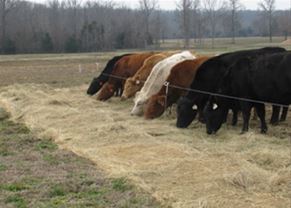



Taking Care of Your Farm Over Winter
December brings with it opportunities to manage soil fertility and control weeds, Arkansas producers have been told.Soil pH and annual weeds can be addressed, advises the University of Arkansas, division of agriculture.
So too should inefficiencies in grazing and forage provision.
Winter rains leach nutrients, lowering pH in pasture as calcium carbonates disappear. This is, in part, due to pasture soils not being mixed as frequently as tilled cropland.
Meanwhile, once weeds have been identified, pastures should be sprayed. Now is a perfect time to address buttercup, thistle and henbit as all are germinating.
Waste is a problem when feeding hay on pastures at this time of year. The first thing producers can do is feed it in rings.
“Unrolling hay increases hay waste unless it is done on a limit-feeding basis,” said the department.
To avoid hay trampling, temporary electric fences can be used to increase utilization.

- Unroll the bale, then string up an electrified polywire down the length of the line of hay.
- Place the wire about 30 inches high over the hay.
- Cattle will line up as if eating at a feed bunk.
When grazing, US ranchers are reminded to be wary for poisoning, especially following frosts or in oak meadows, which should be avoided.
The extension said: “Exclude cattle from access to oak trees whenever possible. Acorns are falling and are toxic to cattle causing kidney damage and death.”
Johnsongrass pasture requires a week to recover following the first frost. When frost damaged, the grass can be fatal for cattle.
“Do not use frost-damaged Johnsongrass as pasture for seven days after the first killing frost," said the extension.
“Johnsongrass may contain prussic acid which can cause sudden death in cattle.”
Those grazing bermudagrass should have “grazed out” by January 1, the same goes for brassicas such as turnips and rape.

They warn against continuous grazing.
Instead, trampling of fodder should be avoided through rotation or limit-grazing methods, the extension advisers add.
Any small grains should be left until canopy height reaches 8 inches.
“Under limit-grazing, cows are routinely pastured on dormant pasture or fed hay in a dry-lot, but are allowed to eat their fill from a limited-access winter annual pasture several times per week,” said the extension.
“Limit-grazing of beef cows and calves on a mixture of wheat/rye/ryegrass (planted at 0.2 acre of per head) for two days per week produced the same cow, calf, and rebreeding performance as cows fed unlimited hay plus a supplement.”
“Limit-grazed cows also consumed 30 percent less hay during the winter feeding period.”


